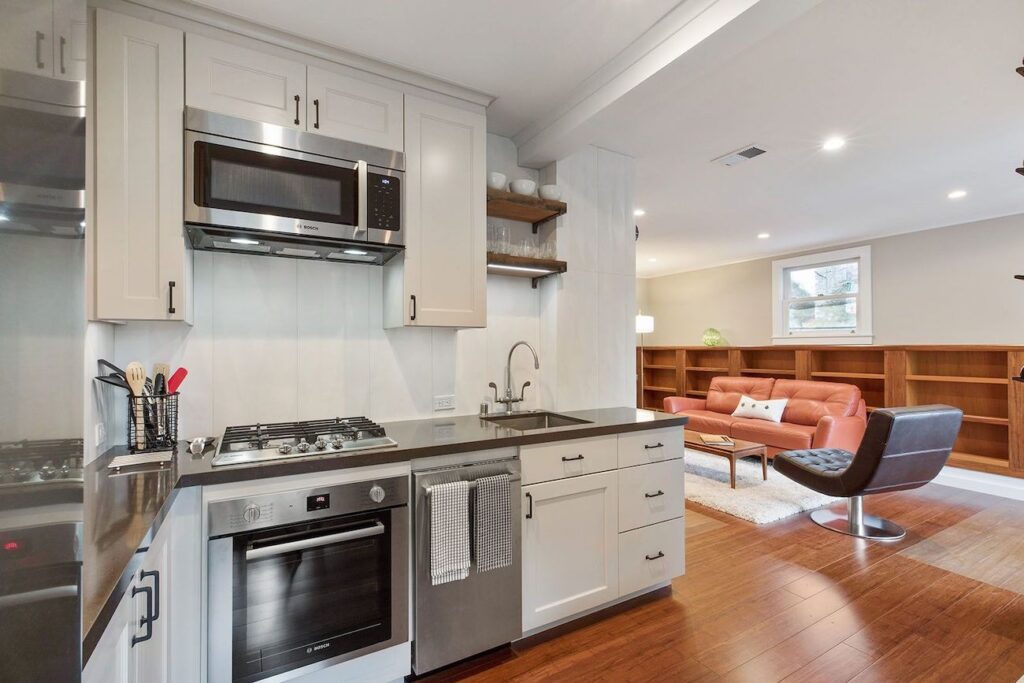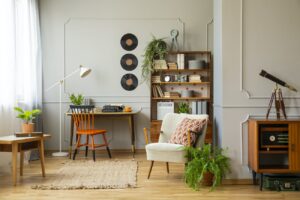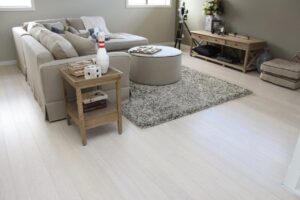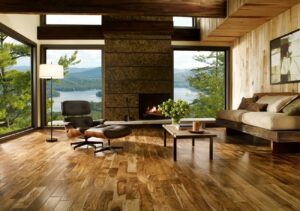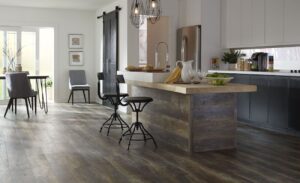In the world of bamboo flooring, the process of turning bamboo grass materials into bamboo flooring planks are relatively different. By understanding the solid and engineered bamboo flooring as the available options, people will surely be able to choose the type of bamboo that suit their project well.
The way solid and engineered bamboo flooring are manufactured is different to present the specific characteristics, making them either more or less desirable in a certain environment.
To what extent do they show differences? And which one of the two bamboo flooring types will be more suitable to meet your needs and project?
Let’s take a quick look about the two bamboo flooring types in the review sections below.
The Conventional Use Of Bamboo in Home Flooring
Naturally, the world’s largest species of grass lists bamboo in the first rank for its suitability for certain flooring application. It is due to the fact that bamboo possesses a hard outer shell that is recognizable good for flooring materials.
In Eastern Asia, traditional bamboo flooring is constructed by slicing the bamboo stalks into the thin boards and nailing them down to the subfloors. This method is still applicable in some villages up to now.
On the contrary, these modern years use the technology to manufacture the bamboo flooring. There are as many as five different bamboo flooring types which are all grouped into the two general categories.
The first category is the solid bamboo flooring that comes with the solid boards, glued down together to create flooring planks.
The second bamboo flooring category that is popularly used is engineered bamboo that is constructed from the bamboo thin layer bonded to a wood.
Solid Bamboo Flooring
Vertical Grain and Flat Grain of Solid Bamboo Flooring
Understanding the solid and engineered bamboo flooring will involve vertical grain and flat grain. They both are the two forms of solid bamboo flooring that comes with their own characteristics either the look or the function.
Vertical grain naturally has a bamboo look and is added by the rich features on the surface, letting the dirt hide well on the flooring while the room keeps looking good.
This vertical grain solid bamboo flooring is constructed through the process of lining up, straight up and down, pressed by bonding it on its both side. This will add special strength to the solid bamboo flooring so that it is applicable for the desired rooms.
On the other hand, the flat grain of solid bamboo flooring is designed with the fewer features but more consistent appearance. Flat-grain is also designed to resemble the real look of bamboo materials.
As one of the solid bamboo types, flat-grain has flat chips one atop the other. That’s why, it results only a few features.
However, flat-grain solid bamboo is the most widely used type of bamboo flooring installed by many people around the world.
Apart from the differences between vertical grain and flat grain of solid bamboo flooring, both of them presents the most natural and wonderful look of bamboo materials.
These two types of solid bamboo are noticeably proper for bedrooms, home offices, dens, living rooms and even for kitchens along with the precautions that are taken into consideration.
One thing to remember, these solid bamboo flooring types are not recommended for bathrooms or other home areas with below-grade installation.
The Process of Manufacturing Solid Bamboo Flooring
Understanding the solid and engineered bamboo flooring will never be complete without knowing how it is manufactured.
In fact, bamboo is typically hard, brittle and uneven, making it rarely used in modern flooring applications.
However, it is processed in particular way presenting its own benefits and characteristics. As a result, this solid bamboo flooring proves its versatility.
Manufacturing solid bamboo is started by slicing the bamboo stalks into a very thin boards. The next step is removing the skin out of the materials and boiling it in boric acid. This process will help you clear the bamboo from any bacteria or microorganism that might be damaging the bamboo.
Later on, the slices will be coated by the particular adhesive and bonded into solid boards using the pressure and heat. The final appearance is determined by the lined up pieces to form flat grain and vertical grain of solid bamboo flooring.
When the adhesive dry up, the bamboo flooring must be treated by sanding it to ensure the smoothness of the surfaces.
For the process of curing, a UV layer is added to complete the material finish. However, before arriving at the retailers for sale, the flooring is frequently stained and finished.
Installation of Solid Bamboo Flooring
Either vertical-grain or horizontal-grain, solid bamboo is available in planks with tongue and groove, allowing you to install the flooring like the way you do with the traditional hardwood flooring using blind, nailing and adhesive.
Pros and Cons of Solid Bamboo Flooring
In relation to understanding the solid and engineered bamboo flooring, there are some pros and cons of solid bamboo flooring you have to take a look.
Beneficially, solid bamboo flooring can be refinished and sanded anytime it scratches. It is also very solid without flex underfoot. Moreover, this flooring is less harmful of outgassing though it uses adhesive for the installation.
The downsides of this solid flooring type is the effortful installation. It is also less durable and not recommended for areas with high humidity such as bathrooms.
Read Also: Carpet Flooring Reviews, Pros Cons, Pricing & Best Brands
Strand-Woven Solid Bamboo Flooring
From the top to the bottom, strand-woven solid bamboo comes from the top to the bottom. This flooring typed is constricted from the pulped bamboo which is pressed to create dense blocks of solid bamboo materials.
It is sliced into tiles and planks later on. Due to the use of adhesive in a greater amount in the weight, strand-woven solid bamboo tend to be more durable than the solid one.
True to its construction, strand-woven solid bamboo is very much suitable for dry installation for areas such as living rooms, bedrooms and hallways. It is not recommended to use for wet areas like bathrooms, laundry rooms and kitchens.
The Process of Manufacturing Strand-Woven Solid Bamboo Flooring
Manufacturing this strand-woven solid bamboo flooring starts by slicing the bamboo stalks, removing the skins and boiling the strips in boric acid.
This is aimed to kill any bacteria or microorganism. This way, the stalks are processed into a thick pulp where the individual bamboo pieces are tightly interwoven.
Mix the pulp with the adhesive substance and inject the material into a mold. Urge the mixture into a solid board using the heat and pressure. When the adhesive is dry, the boards are sliced into individual planks.
This way, strand-woven solid bamboo flooring comes in the tongue-and-groove planks. Finally the product is sanded overtime and the finishing agents are applied before the products are distributed for sale.
Installation of Strand-Woven Solid Bamboo Flooring
Similar to hardwood, the strand-woven solid bamboo flooring is installed on the plywood or subfloor using the tongue-and-groove forms, nailed or glued down.
The products which are the click-lock forms are installed without using permanent attachment. Well, they are just floating over a paper or underlayment.
Pros And Cons of Strand-Woven Solid Bamboo Flooring
The hardness of this strand-woven solid bamboo provides a high durability. In addition, it is possible to refinish the planks when it scratches or dents.
However, a few people do not like this flooring type because of the difficult installation. The used of adhesive is also containing volatile organic compounds that is harmful for human health.
Moreover, the manufacturing process makes the materials less natural. And, this flooring type is suitable only for dry environment.
Engineered Bamboo Floors
Now it’s time to check out more about engineered bamboo floors as a part of understanding the solid and engineered bamboo flooring.
Though it may look similar to the solid bamboo, engineered bamboo looks more natural in its bamboo-look in each of pieces.
This engineered bamboo planks consist of thin bamboo layer adhered to the backing layer and coated using the wear layer for protection.
Engineered bamboo flooring is considered more stable and easy to care for. Nowadays, this flooring type is available in click-together tiles and planks that everyone can install through the DIY options.
Luckily, you will be able to remove the damaged individual tiles and replace them with another pieces when they scratches.
Additionally, this flooring type is designed to suit wet environments though it requires you to carefully concern the caution.
Along with the proper installation and maintenance, engineered bamboo flooring is just a great option for high-traffic environments.
The Process of Manufacturing Engineered Bamboo Flooring
Engineered bamboo flooring is similarly manufactured like the solid strand-woven bamboo. But the thin veneer layers are cut down out of the bamboo molded blocks. Later, it is processed and bonded to the base layer of fiberboards.
The natural plywood layer is coated by the clear layer and the bottom of the sheets is added by the waterproof agents. Later, the product is finished by the tongue-and-groove before being distributed for sale.
Installation of Engineered Bamboo Flooring
Engineered bamboo flooring is relatively easy to install. It is usually installed as a floating floor over an underlayment. Since it has already a click-lock feature, you will not need adhesive to attach the material on the subfloor.
Pros and Cons of Engineered Bamboo Flooring
Some people loves this engineered bamboo flooring for their wet environments due to the easy installation, waterproof coating, moisture resistant and stable dimensionality that makes the flooring product uneasy to shrink and expand.
The downside of this flooring type includes the incapability of the product to be refinished. Moreover, the floating installation technique sometimes leaves a flex to the floor.
Read Also: What is Strand Woven Bamboo Flooring and Purchase It For A Higher Durability
Cost
Cost is also one of the part of understanding the solid and engineered bamboo flooring that you need to know well.
This way, both the vertical and horizontal grain of solid bamboo will cost around $2 to $4 per square foot. Meanwhile, the strand-woven solid bamboo is relatively higher about $3 to $5 per square foot.
Engineered bamboo flooring costs are quite comparable. It runs between $2 and $5 per square foot depending on the product thickness and the layer quality.
Final Words
Now that you have known more about the bamboo flooring either the solid or the engineered one, you must be able to choose the right product for your home.
